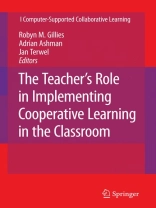Cooperative learning is widely endorsed as a pedagogical practice that promotes student learning. Recently, the research focus has moved to the role of teachers’ discourse during cooperative learning and its effects on the quality of group discussions and the learning achieved. However, although the benefits of cooperative learning are well documented, implementing this pedagogical practice in classrooms is a challenge that many teachers have difficulties accomplishing.
Difficulties may occur because teachers often do not have a clear understanding of the basic tenets of cooperative learning and the research and theoretical perspectives that have informed this practice and how they translate into practical applications that can be used in their classrooms. In effect, what do teachers need to do to affect the benefits widely documented in research?
A reluctance to embrace cooperative learning may also be due to the challenge it poses to teachers’ control of the learning process, the demands it places on classroom organisational changes, and the personal commitments teachers need to make to sustain their efforts. Moreover, a lack of understanding of the key role teachers need to play in embedding cooperative learning into the curricula to foster open communication and engagement among teachers and students, promote cooperative investigation and problem-solving, and provide students with emotionally and intellectually stimulating learning environments may be another contributing factor.
The Teacher’s Role in Implementing Cooperative Learning in the Classroom provides readers with a comprehensive overview of these issues with clear guidelines on how teachers can embed cooperative learning into their classroom curricula to obtain the benefits widely attributed to this pedagogical practice. It does so by using language that is appropriate for both novice and experienced educators. The volume provides: an overviewof the major research and theoretical perspectives that underpin the development of cooperative learning pedagogy; outlines how specific small group experiences can promote thinking and learning; discusses the key role teachers play in promoting student discourse; and, demonstrates how interaction style among students and teachers is crucial in facilitating discussion and learning. The collection of chapters includes many practical illustrations, drawn from the contributors’ own research of how teachers can use cooperative learning pedagogy to facilitate thinking and learning among students across different educational settings.
İçerik tablosu
Social Interdependence Theory and Cooperative Learning: The Teacher’s Role.- Beyond the Classroom and into the Community: The Role of the Teacher in Expanding the Pedagogy of Cooperation.- Pupil Grouping for Learning: Developing a Social Pedagogy of the Classroom.- Structuring Peer Interaction to Promote Higher-Order Thinking and Complex Learning in Cooperating Groups.- Cooperative Learning and Literacy Instruction in Middle Level Education.- Structuring Group Interaction to Promote Thinking and Learning During Small Group Learning in High School Settings.- Feedback and Reflection to Promote Student Participation in Computer Supported Collaborative Learning: A Multiple Case Study.- School and Inclusive Practices.- Developing Language and Mastering Content in Heterogeneous Classrooms.- Teacher Practices and Small-Group Dynamics in Cooperative Learning Classrooms.- Explanation Giving and Receiving in Cooperative Learning Groups.- Teachers’ and Students’ Verbal Behaviours During Cooperative Learning.












